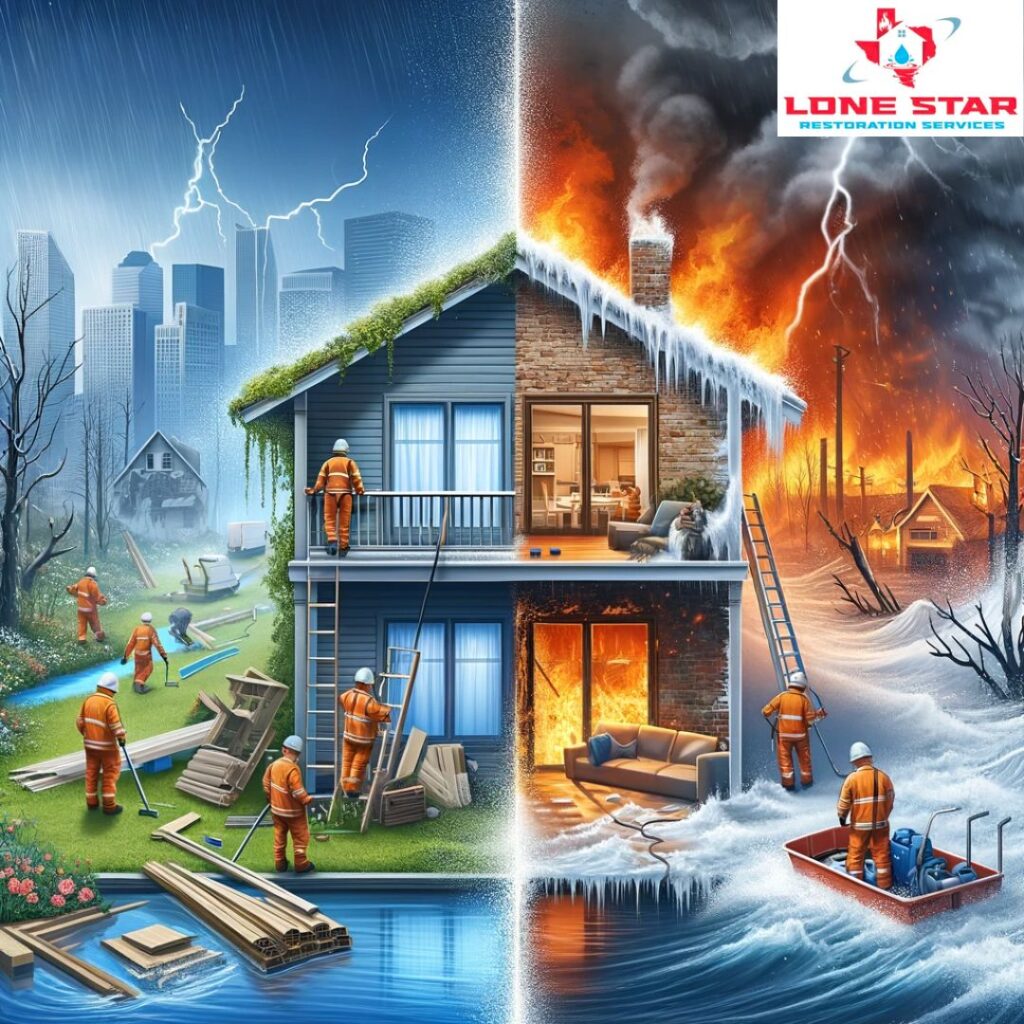Adapting to Climate Change: The Evolving Landscape of Property Restoration
In recent years, the world has witnessed an unmistakable upsurge in climate-related disasters. From raging wildfires to devastating floods and increasingly severe hurricanes, the impacts of climate change are no longer distant predictions but present realities. These environmental upheavals are leaving an indelible mark on properties, both residential and commercial, challenging the conventional paradigms of property restoration and maintenance.
As we step into this era of environmental uncertainty, the field of property restoration is encountering unprecedented demands. The traditional methods of restoration are being tested, and there’s a growing need for more resilient and adaptable strategies to cope with the damages inflicted by these climate-induced extremes.
This blog seeks to delve into this critical intersection of climate change and property restoration. We aim to explore the evolving dynamics of this relationship – how the increasing frequency and severity of weather-related events are reshaping the demand and approaches in the restoration industry. From the latest in innovative restoration techniques designed to combat extreme weather damages to proactive measures that property owners can adopt, we will navigate through the nuances of this ‘new normal’.
Our journey will not only highlight the challenges but also the opportunities for innovation and adaptation that lie ahead. As we unpack these themes, the goal is to offer insights and practical guidance, equipping property owners and restoration professionals with the knowledge and tools to effectively respond to the challenges posed by a changing climate. Let’s embark on this exploration to understand and prepare for the impacts of climate change on property restoration.
The Reality of Climate Change and Its Impact on Properties
Climate change is no longer a distant threat; it is a present-day reality with tangible impacts, particularly on residential and commercial properties. The manifestation of climate change comes in various forms – increased rainfall leading to floods, extended droughts causing wildfires, and more frequent and intense hurricanes and storms. Each of these events poses a unique set of challenges to properties, demanding a robust response from the property restoration industry.
The evidence of climate change’s impact on properties is overwhelming. For instance, the increase in coastal flooding has led to more frequent water damage in homes and businesses near shorelines. Similarly, areas prone to wildfires experience not only the direct damage from flames but also secondary effects like smoke damage and weakened structures. In regions where hurricanes and storms are becoming more common, the destruction includes everything from broken windows and torn roofs to complete structural collapses.
Recent statistics paint a stark picture. According to [Insert relevant and recent study or statistics], there has been a significant increase in the number of properties affected by climate-related disasters in the past decade. This trend is not just limited to one region or type of property; it is a global phenomenon affecting diverse communities and infrastructure.
Understanding the reality of these impacts is crucial for both property owners and restoration professionals. It sets the stage for a more informed approach to restoration and preparedness, recognizing that the methods and strategies that worked in the past may no longer be sufficient in the face of these evolving environmental challenges. As we continue, we will explore how the demand for restoration services is growing in response to these changes and what this means for the industry and property owners alike.
Increased Demand for Restoration Services
The direct consequence of the escalating impact of climate change on properties is a substantial increase in the demand for restoration services. As extreme weather events become more frequent and intense, the number and severity of property damages escalate correspondingly, leading to an unprecedented need for comprehensive restoration solutions.
In regions that are increasingly experiencing severe weather patterns, the restoration industry is witnessing a surge in service requests. This trend is not only limited to emergency responses post-disaster but also encompasses a growing need for preventive measures and resilience-building against future climate-related events. Homeowners, business operators, and government entities are all seeking effective ways to restore and reinforce structures to withstand the harsh realities of a changing climate.
The nature of the damages incurred is also evolving. Unlike conventional restoration demands, which often involved isolated incidents of water or fire damage, current scenarios frequently entail a complex mix of issues. For instance, a hurricane might bring not just flood damage but also structural impairments, mold proliferation due to prolonged dampness, and electrical hazards. This complexity requires a multifaceted approach to restoration, one that integrates various expertise and technologies.
Statistics from insurance claims and restoration service providers indicate a marked increase in the volume and complexity of restoration projects in recent years. Data shows that the frequency of claims related to climate-induced damages has risen, reflecting a broader trend of escalating environmental challenges. This increase is not just a statistical anomaly; it represents a fundamental shift in the landscape of property restoration, driven by the realities of climate change.
As the demand for restoration services grows, so does the need for the industry to adapt and evolve. The following sections will delve into how restoration techniques are being redefined in the face of extreme weather conditions and what this means for the future of property restoration.
Adapting Restoration Techniques for Extreme Weather
In response to the more extreme weather conditions brought on by climate change, the property restoration industry is rapidly adapting its techniques. Traditional methods are being supplemented, and in some cases replaced, by more advanced and robust solutions. These innovations are critical in addressing the unique challenges posed by climate-induced damages.
For instance, in areas prone to flooding, restoration companies are increasingly utilizing high-powered water extraction equipment and advanced dehumidification technology. This equipment can quickly remove large volumes of water and reduce humidity levels, minimizing the long-term effects of water damage such as mold growth and structural weakening.
Similarly, in regions where wildfires are a growing concern, new fire restoration techniques are being employed. These include specialized soot and smoke removal processes and treatments to neutralize odors. The focus is on not only restoring the physical damage but also ensuring the indoor air quality is safe for inhabitants.
In hurricane-prone areas, restoration services now often include fortifying structures against future storms. This might involve reinforcing roofing, windows, and walls to withstand high winds and heavy rainfall. Such proactive measures are becoming a crucial part of the restoration process, going beyond mere repair to enhance resilience.
Proactive Measures for Property Owners
In the face of these changing dynamics, it’s not just restoration professionals who need to adapt – property owners also have a critical role to play. There are several proactive measures that homeowners and business owners can take to mitigate the risk of climate-related damage.
Firstly, regular maintenance and inspections can identify potential vulnerabilities in a property’s structure and systems. Addressing these issues early can prevent more significant damage in the event of extreme weather. Additionally, property owners are increasingly looking into weatherproofing options, such as installing flood barriers or fire-resistant materials, as part of their regular upkeep.
Educating property owners on the importance of emergency preparedness is also vital. This includes creating and maintaining an emergency response plan, having adequate insurance coverage, and understanding the basics of first-response damage control.
Sustainability in Restoration Practices
As the restoration industry responds to the challenges posed by climate change, there’s a growing emphasis on incorporating sustainable practices. This shift is not only about addressing immediate restoration needs but also about contributing to broader environmental efforts.
Sustainable restoration practices include using eco-friendly materials and methods that reduce the carbon footprint of the restoration process. For example, sourcing local materials for repairs or using green cleaning products can significantly impact the overall sustainability of a project.
Additionally, restoration companies are exploring ways to reduce waste during the restoration process. This includes recycling materials when possible and disposing of waste in an environmentally responsible manner.
Conclusion
The intersection of climate change and property restoration presents both challenges and opportunities. As extreme weather events become more common, the demand for skilled restoration services is set to rise. This increased demand drives innovation in the industry, leading to more effective and sustainable restoration practices.
Looking ahead, the restoration industry must continue to evolve, embracing new technologies and methods to address the complex challenges presented by a changing climate. For property owners, staying informed and proactive is key to navigating this new normal.
In conclusion, while climate change poses significant challenges to property restoration, it also catalyzes progress and adaptation in the industry. By working together, restoration professionals and property owners can build resilience and ensure that properties are not only restored but also better prepared for the future.





